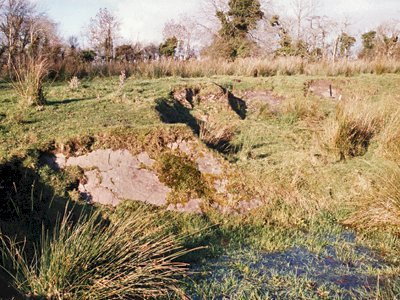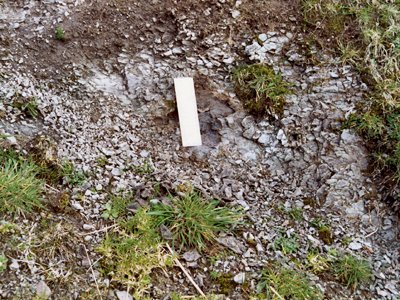Earth Science Conservation Review
| Tedd Cross Roads Segment, Cloghfin | Fermanagh |
| Site Type: | Inland exposure |
| Site Status: | ASSI |
| Council area: | Fermanagh District Council |
| Grid Reference: | H25866148 |
| Google maps: | 54.50082,-7.60176 |
| Rocks | |
|---|---|
| Rock Age: | Devonian (Middle Devonian, Upper Devonian) |
| Rock Name: | Fintona Group, Tedd Formation |
| Rock Type: | Mudstone, Sand, Sandstone, Siltstone |
| Interest | |
| Fossil Groups: | Miospore, Miospores |
| Other interest: | dessication cracks, ripple marks |
Summary of site:
At this locality a green mudstone, 40cm thick, is interbedded with purple to red coloured fine sandstones, siltstones and thin sheets of chocolate brown mudstone. The outcrop is on one of several sub-parallel rock ridges in the area. The rocks were deposited in shallow water and show clear ripple marks. Polygonal desiccation cracks are present, showing that the sediments dried out completely for long periods. All these rocks are part of the Devonian Tedd Formation and are estimated to lie about 300m above its base.
The green mudstone is the key component here because it has yielded a flora of microscopic spores that were originally tentatively placed in the late Devonian. The full account accompanying this summary was written at that time. Subsequent research places this flora in the early Devonian, around 390-400 million years ago.
For details of the environment and geography of the period see site record ‘Devonian - Shanmullagh Formation: Miospore localities' and site record ‘Devonian - Shanmullagh Formation: stratotype localities'.
The site is on agricultural land and could possibly be threatened by land improvement.
The green mudstone is the key component here because it has yielded a flora of microscopic spores that were originally tentatively placed in the late Devonian. The full account accompanying this summary was written at that time. Subsequent research places this flora in the early Devonian, around 390-400 million years ago.
For details of the environment and geography of the period see site record ‘Devonian - Shanmullagh Formation: Miospore localities' and site record ‘Devonian - Shanmullagh Formation: stratotype localities'.
The site is on agricultural land and could possibly be threatened by land improvement.
| Enlander, I., Dempster, M. & Doughty, P., 2025. Tedd Cross Roads Segment, Cloghfin, County Fermanagh, site summary. [In] Earth Science Conservation Review. https://www.habitas.org.uk/escr/summary.php?item=315. Accessed on 2025-04-03 |
| Previous Site | Next Site |

